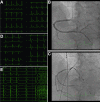Syncope caused by coronary artery spasm without chest pain leading to ventricular fibrillation
- PMID: 23749837
- PMCID: PMC3703059
- DOI: 10.1136/bcr-2013-010210
Syncope caused by coronary artery spasm without chest pain leading to ventricular fibrillation
Abstract
We present a case of syncope caused by coronary artery spasm without chest pain leading to ventricular fibrillation despite of vasodilator therapy with a calcium channel blocker (CCB). A 68-year-old man presented with two episodes of syncope without chest pain. Ergonovine provocation test induced a diffuse spasm in the right coronary artery (RCA) and subsequently, ventricular fibrillation. Under the therapy with multiple vasodilators including two CCBs, a second ergonovine provocation induced a spasm of the proximal RCA resulting in complete obstruction. Owing to drug-resistant coronary spasm complicated by ventricular fibrillation, an implantable cardioverter defibrillator (ICD) was implanted. This case report highlights the occurrence of syncope caused by coronary artery spasm without chest pain that was refractory to single CCB therapy and needed ICD implantation. Therapy with multiple vasodilators, including two or more CCBs, along with ICD implantation may be required to treat such refractory coronary artery spasms leading to lethal arrhythmia.
Figures


References
-
- Meune C, Joly LM, Chiche JD, et al. Diagnosis and management of out-of-hospital cardiac arrest secondary to coronary artery spasm. Resuscitation 2003;2013:145–52 - PubMed
-
- Chevalier P, Dacosta A, Defaye P, et al. Arrhythmic cardiac arrest due to isolated coronary artery spasm: long-term outcome of seven resuscitated patients. J Am Coll Cardiol 1998;2013:57–61 - PubMed
-
- Meisel SR, Mazur A, Chetboun I, et al. Usefulness of implantable cardioverterdefibrillators in refractory variant angina pectoris complicated by ventricular fibrillation in patients with angiographically normal coronary arteries. Am J Cardiol 2002;2013:1114–16 - PubMed
-
- Looi KL, Grace A, Agarwal S. Coronary artery spasm and ventricular arrhythmias. Postgrad Med J 2012;2013:465–71 - PubMed
Publication types
MeSH terms
LinkOut - more resources
Full Text Sources
Other Literature Sources
Medical
